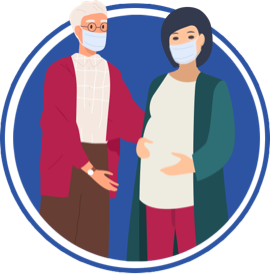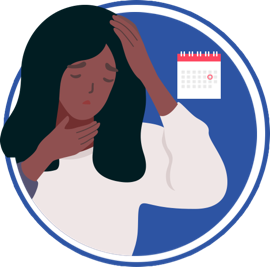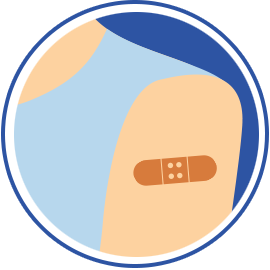 The Wellness Coalition is working throughout the River Region to increase awareness and access to vaccinations for both of these viruses. In addition to spreading the news via social media and other means of communications, we have partnered with numerous clinics, pharmacies, and community organizations to hold health fairs in Lowndes, Macon, and Montgomery counties.
The Wellness Coalition is working throughout the River Region to increase awareness and access to vaccinations for both of these viruses. In addition to spreading the news via social media and other means of communications, we have partnered with numerous clinics, pharmacies, and community organizations to hold health fairs in Lowndes, Macon, and Montgomery counties.
“One of the best ways to combat the myths and falsehoods that have spread about COVID-19, the flu, and vaccines is to continue to circulate information vetted by science,” said Na’Sha DeRemus, REACH COVID/Flu coordinator at The Wellness Coalition. “One other way is to take the time to listen to people who are unsure about what they are hearing so that we can address their concerns with the latest and most accurate information.”
THE QUICK TAKE
Influenza (flu) and COVID-19 are both contagious respiratory illnesses, but they are caused by different viruses. COVID-19 is caused by infection with a coronavirus first identified in 2019. Flu is caused by infection with a flu virus.
From what we know, COVID-19 spreads more easily than flu. Compared to flu, COVID-19 can cause more serious illnesses in some people. COVID-19 can also take longer before people show symptoms, and people can remain contagious for longer periods of time.
You cannot tell the difference between flu and COVID-19 just by looking at the symptoms alone because they have some of the same symptoms. That’s why testing is needed to tell what the illness is and to confirm a diagnosis. Testing is also important because it
can reveal if someone has both the flu and COVID-19 at the same time.

SIGNS & SYMPTOMS
Both COVID-19 and flu can have varying degrees of symptoms, ranging from no symptoms (asymptomatic) to severe symptoms. Common symptoms that COVID-19 and flu share include:
- Fever or feeling feverish/having chills
- Cough
- Shortness of breath or difficulty breathing
- Fatigue (tiredness)
- Sore throat
- Runny or stuffy nose
- Muscle pain or body aches
- Headache
- Vomiting
- Diarrhea
- Change in or loss of taste or smell, although this is more frequent with COVID-19

HOW LONG SYMPTOMS APPEAR AFTER EXPOSURE & INFECTION
Similarities: For both COVID-19 and flu, 1 or more days can pass from when a person becomes infected to when they start to experience symptoms of illness.
Differences: If a person has COVID-19, it could take them longer to experience symptoms than if they have flu.
- Flu – Typically, a person may experience symptoms anywhere from 1 to 4 days after infection.
- COVID-19 – Typically, a person may experience symptoms anywhere from 2 to 14 days after infection.

PEOPLE AT HIGHER RISK FOR SEVERE ILLNESS
Similarities: Both COVID-19 and flu illness can result in severe illness and complications. Those at highest risk include:
- Older adults
- People with certain underlying medical conditions (including infants and children)
- Pregnant people
Differences: Overall, COVID-19 seems to cause more serious illnesses in some people. Serious COVID-19 illness resulting in hospitalization and death can occur even in healthy people.
Some people that had COVID-19 can go on to develop post-COVID conditions or multisystem inflammatory syndrome (MIS).

HOW LONG SOMEONE CAN SPREAD THE VIRUS
Similarities: For both COVID-19 and flu, it’s possible to spread the virus for at least 1 day before experiencing any symptoms.
Differences: If a person has COVID-19, they could be contagious for a longer time than if they have flu.
- Flu – Most people with flu are contagious for about 1 day before they show symptoms. Older children and adults with flu appear to be most contagious during the first 3-4 days of their illness, but many people remain contagious for about 7 days. Infants and people with weakened immune systems can be contagious for even longer.
- COVID-19 – How long someone can spread the virus that causes COVID-19 is still being studied.
What we know from studies of prior variants, including Delta:
- On average, people can begin spreading the virus 2-3 days before their symptoms begin, but infectiousness peaks 1 day before their symptoms begin.
- On average, people can continue to spread the virus another 8 days after their symptoms began.
- This information is from studies of prior variants. We still have much to learn about new variants, including Omicron. CDC will share findings from ongoing studies as soon as they are available.

VACCINATION
Similarities: Vaccines COVID-19 and flu are approved and/or authorized for emergency use by the FDA.
Differences:
- Flu – There are multiple FDA-licensed influenza vaccines produced annually to protect against the 4 flu viruses that scientists expect will circulate each year.
- COVID-19 – Three COVID-19 vaccines are authorized or approved for use in the United States to help prevent COVID-19. Pfizer BioNTech or Moderna (COVID-19 mRNA vaccines) are preferred. You may get Johnson & Johnson’s Janssen COVID-19 vaccine in some situations. Other vaccines to prevent COVID-19 are under development.
